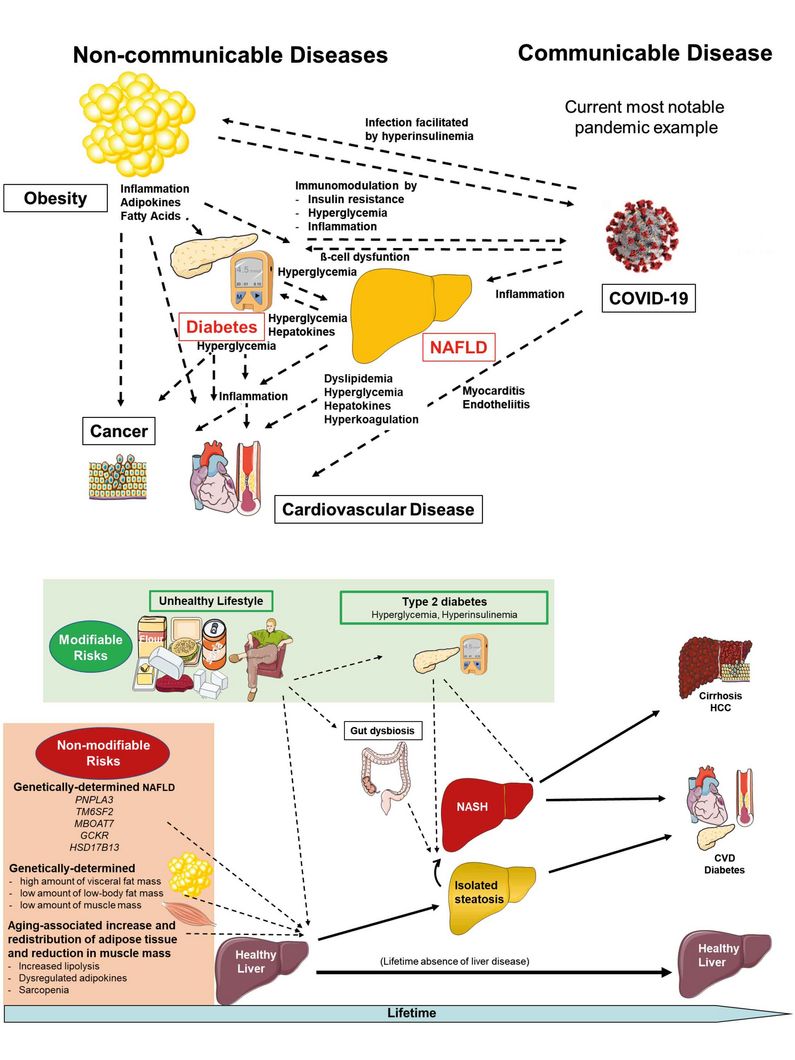Tübingen, 25.02.2022
Mechanisms in the Development of Fatty Liver Disease and Diabetes
Non-alcoholic fatty liver disease (NAFLD) has become an epidemic, similar to the non-communicable diseases cancer, obesity, cardiovascular disease and diabetes. In a review article in ‘The Lancet Diabetes & Endocrinology’, Norbert Stefan and Kenneth Cusi first highlight the extent to which NAFLD and diabetes jointly occur worldwide. Then they address the major mechanisms that are involved in the pathogenesis of NAFLD and type 2 diabetes and discuss whether these mechanisms place NAFLD in an important position to better prevent and treat non-communicable diseases and the communicable disease COVID-19. Finally, using a holistic approach, integrating knowledge from early childhood development to older age, they propose solutions how this knowledge can be used for personalized prevention and treatment of NAFLD in the future.
Worldwide more than 25% of adults and 3-10% of children have NAFLD. These numbers increase to about 60% and 40% in adults and children with obesity and/or diabetes. These numbers are alarming, because NAFLD, and more so non-alcoholic steatohepatitis (NASH) and NAFLD-associated hepatic fibrosis, increase the risk of advanced liver diseases (e.g. hepatic cirrhosis, hepatic cancer) and cardiometabolic diseases (e.g. cardiovascular disease, type 2 diabetes).
Professor Kenneth Cusi from the University of Florida (USA) highlights: ‘Because the highest prevalence of NASH and hepatic fibrosis is observed in patients with type 2 diabetes, the disease which epidemically increased during the past decades, focusing on the interplay of NAFLD with type 2 diabetes may help to better understand the major mechanisms that propel the worldwide increase of NAFLD.’ By doing just that, the authors identify increased energy-dense food and fructose consumption, as well as genetically-determined visceral fatness and impaired capacity of fat deposition in the lower part of the body as important drivers of NAFLD and type 2 diabetes. The interplay of fatty liver and diabetes, involving subclinical inflammation, insulin resistance, increased glucose levels, dysregulated liver-derived proteins (hepatokines), dyslipidemia and hypercoagulation of the blood, amplifies the impact both diseases on each other, as well as of an unhealthy lifestyle and genetic risk on the development of other non-communicable diseases, such as cancer and cardiovascular disease. Importantly, the same mechanisms (subclinical inflammation, high glucose levels and insulin resistance) also increase the risk of a severe course of COVID-19.
Professor Norbert Stefan from the University of Tübingen, the Institute for Diabetes Research and Metabolic Diseases (IDM) of the Helmholtz Zentrum München (Germany), a partner of the German Center for Diabetes Research (DZD), adds: ‘Metabolic pathways are key in understanding why NAFLD develops and how it impacts on other diseases. Therefore, it is now time to use a holistic approach to study the pathogenesis of NAFLD.’ This proceeding involves the integration of knowledge about non-modifiable risk factors, such as genetically-determined fatty liver and unhealthy storage of fat and ageing-associated redistribution of fat and decrease in muscle mass. Furthermore, modifiable risk factors, such as malnutrition in early and later stages of life, and metabolic risks, such as high glucose and insulin levels, need to be early on identified and treated.
The authors of the review believe that in the future, the application of these concepts will enable a personalized risk prognosis and individualized treatment of NAFLD. In addition, researchers will be able to specifically develop lifestyle modification programs and drugs for the respective subtypes based on the various aspects of this disease.

© N. Stefan/K. Cusi
Original publication:
Norbert Stefan, Kenneth Cusi. A global view of the interplay between non-alcoholic fatty liver disease and diabetes. The Lancet Diabetes & Endocrinology 2022, DOI: 10.1016/S2213-8587(22)00003-1
Media contact:
Norbert Stefan, MD, PhD
Professor of Medicine
Heisenberg Professorship of Clinical and Experimental Diabetology
Universitäty of Tübingen
Otfried-Müller-Straße 10
72076 Tübingen
Germany
Phone: +49 (0)7071 2980390
Email: norbert.stefan(at)med.uni-tuebingen.de
Kenneth Cusi, M.D., F.A.C.P., F.A.C.E.
Professor of Medicine
Chief, Division of Endocrinology, Diabetes and Metabolism
University of Florida
1600 SW Archer Rd; room H -2
Gainesville
FL 32610-0226
USA
Phone: +1-352-273-8662/7840
Email: Kenneth.Cusi(at)medicine.ufl.edu
Founded in 1805, Tübingen University Hospital is one of the leading centers of German university medicine. As one of the 33 university hospitals in Germany, it contributes to the successful combination of high-performance medicine, research and teaching. Well over 400,000 inpatients and outpatients from all over the world benefit annually from this combination of science and practice. The clinics, institutes and centers unite all specialists under one roof. The experts work together across disciplines and offer each patient the best possible treatment based on the latest research findings. Tübingen University Hospital conducts research for better diagnoses, therapies and healing chances; many new treatment methods are clinically tested and applied here. In addition to diabetology, neuroscience, oncology, immunology, infection research and vascular medicine are research priorities in Tübingen. The Department of Diabetology /Endocrinology has been the center of interdisciplinary research over the past 25 years, especially with the participation of surgery, radiology and laboratory medicine. This important discovery of the prediabetes subtypes was only possible due to the interdisciplinary collaboration between the hospital’s various departments. Tübingen University Hospital is a reliable partner in four of the six German Centers for Health Research initiated by the German Federal Government. www.medizin.uni-tuebingen.de
Press contact

Birgit Niesing
niesing(at)dzd-ev.de
+49 (0)89 3187-3971
 |
